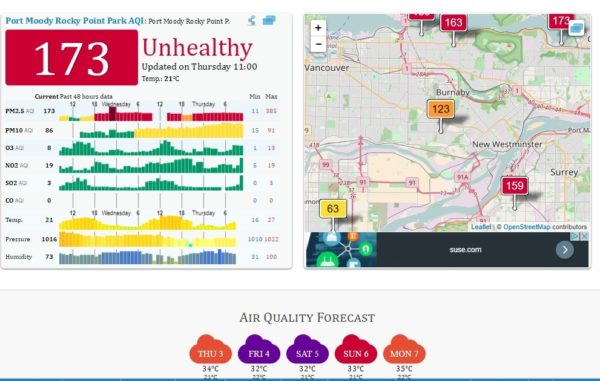
 Air quality in BC’s Lower Mainland is bad. How bad? Currently, we’re talking worse than Los Angeles, worse than Shanghai and Beijing, that kind of bad.
Air quality in BC’s Lower Mainland is bad. How bad? Currently, we’re talking worse than Los Angeles, worse than Shanghai and Beijing, that kind of bad.
Forest fires burning in the province’s interior have caused a hazy, smoke-filled blanketing of the BC’s southwest region, prompting an Air Quality Advisory for Metro Vancouver, the Fraser Valley and virtually the whole southern region of the province from Vancouver Island to the Alberta border.
“Air quality continues to be affected by the current weather pattern over the BC Coast, which has caused outflow winds to transport smoke from wildfires burning in the BC Interior towards our region,” reads an update from Environment Canada. “Concentrations of ground-level ozone are also now expected to reach advisory levels in the eastern portions of Metro Vancouver and the Fraser Valley due to hot weather conditions.”
Much of the southern region of the province remains at “moderate to high risk,” according to Canada’s Air Quality Health Index, which gives ratings of 6 and 7 to Metro’s Southeast and Northeast regions, respectively.
Below: Vancouver’s bad air from a drone…
Canada’s AQHI’s scale runs from low risk (1 to 3) to very high risk (8 to 10) and even “serious” risk (above 10). By comparison, across the country, Toronto in mid-summer smog mode currently sits at an AQHI of 5, while both Halifax and St. John’s on the East Coast are reading low risk at 2.
But for a global ranking, we can turn to the Beijing-based World Air Quality Index, which publishes real time coverage for commuters and city-dwellers in need of up-to-the-minute data on air pollution levels. Using official data from the environmental protection agencies of over 68 participating countries, the WAQI produces a scale from 0 to 300+, with the following ratings:
0 – 50: Good
51-100: Moderate
101-150: Unhealthy for Sensitive Groups
151-200: Unhealthy
201-300: Very Unhealthy
300+: Hazardous
As of Thursday afternoon, North Vancouver squeaks into the Unhealthy category with a 151 rating, while Port Moody/Coquitlam gets an even worse 173. Los Angeles is currently a moderate 82, as is Beijing at 99.
Air quality indices are commonly based on concentration readings for three types of compounds: ground-level ozone, nitrogen dioxide and fine particulate matter (PM2.5), all of which can contribute to poor air quality and negatively impact health, most centrally, lung functioning and the development of diseases such as asthma, bronchitis and lung cancer. Canada’s Air Quality Health Index comes from three-hour average concentrations of the three types of compounds.
In terms of health impacts, fine particulate matter is of special concern, as it involves inhalable particles small enough to cause damage to the lungs and respiratory system. Sources of PM2.5 include combustion engines and solid-fuel sources like coal and biomass, including wood, as well as production emanating from heavy industries like mining and construction.
The World Health Organization states that about three million deaths per year are linked to exposure to outdoor air pollution, with a 2016 report finding that 92 per cent of the world’s population now lives in places where air quality levels exceed WHO limits.
Leave a Reply
You must be logged in to post a comment.




 Share
Share Tweet
Tweet Share
Share




Comment